Science
Universe Sandbox at the American Astronomical Society Conference
Jan 30th
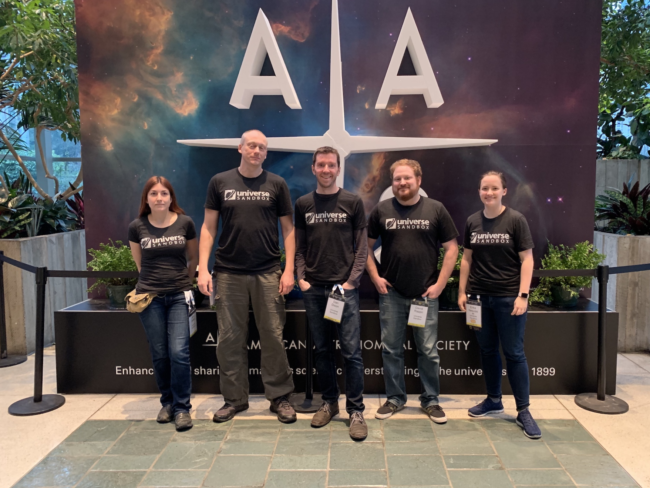
Super Bowl of Astronomy
In early January we gathered some of our team in Seattle, Washington to show off Universe Sandbox at the 233rd meetup of the American Astronomical Society (AAS).
We’ve attended other conferences before that focus on video games, like PAX, but AAS gave us an opportunity to show Universe Sandbox to a different crowd. If you are a researcher, educator, science journalist, or student in the world of astronomy, then AAS is the go-to conference, what some call the “Super Bowl of Astronomy.” And while the government shutdown meant that hundreds of NASA employees who planned on attending couldn’t go, there was still plenty of folk there who had never heard of Universe Sandbox and wanted to learn more.

Come for the Collisions, Stay for the Accurate Mass Loss
Drawing people into our booth was helped a bit by two gigantic TVs showing off some of the usual Universe Sandbox scenarios — you know the ones: Earth melting, stars exploding, moons ripping apart under massive tidal stress.
But what made many attendees stick around and talk to us was the fact that what we were showing not only looked great, but it was also based in science. Universe Sandbox: Come for the fiery collisions, stay for the accurate mass loss when Ceres makes a near pass of a white dwarf!
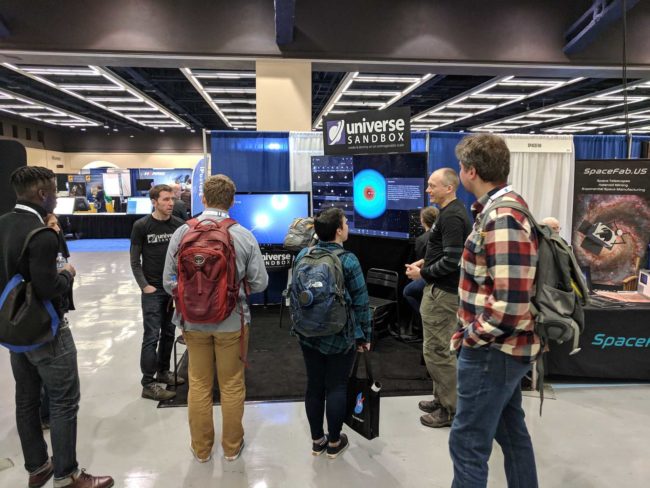
Communicating with Universe Sandbox
In talking to AAS attendees, we hoped to show the potential for using Universe Sandbox for education and visualizations. While most Universe Sandbox players know and appreciate how useful it can be as an educational tool, we want to make sure it gets used in actual classrooms. We believe Universe Sandbox makes it quick and easy to demonstrate astronomy and physics concepts with intuitive and interactive experiments. But don’t take our word for it — here’s astronomy YouTuber Scott Manley with a similar message.
And beyond the classroom, it’s just as quick and easy to use Universe Sandbox for creating visualizations for research, lectures, and articles. There are more sophisticated tools for gathering data with the accuracy needed for research, but there’s nothing quite as convenient as Universe Sandbox for then using the data to create a visual representation, as shown here with the discovery of exoplanets around our nearby star Wolf 1061.
If you’re an educator, a researcher, or are otherwise curious how you can use Universe Sandbox for science communication, please get in touch!
New Year, New Limits of our Solar System for New Horizons
Dec 31st
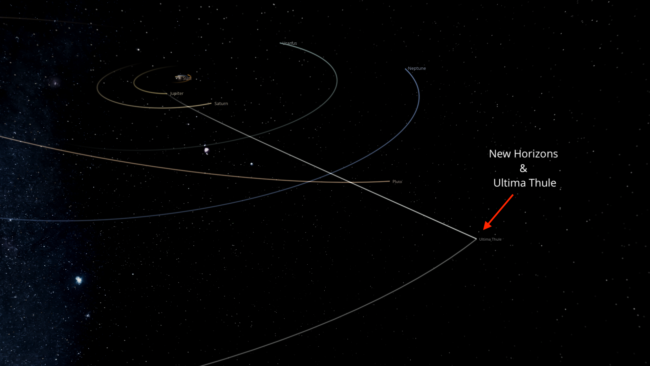
Happy New Year!
While we celebrate one more trip of our beautiful planet around the Sun, the spacecraft New Horizons sets a record for traveling to the most distant object in our Solar System ever visited, 2014 MU69, nicknamed “Ultima Thule.” This object is currently 1 billion miles beyond Pluto, or more than 43 AU from the Sun, which means it is more than 43 times the distance between the Earth and the Sun. New Horizons is expected to make its closest approach to Ultima Thule shortly after midnight EST January 1, 2019.
Check out the flyby in Universe Sandbox:
Home > Open > New Horizons Ultima Thule Encounter in 2019
New Limits for New Horizons
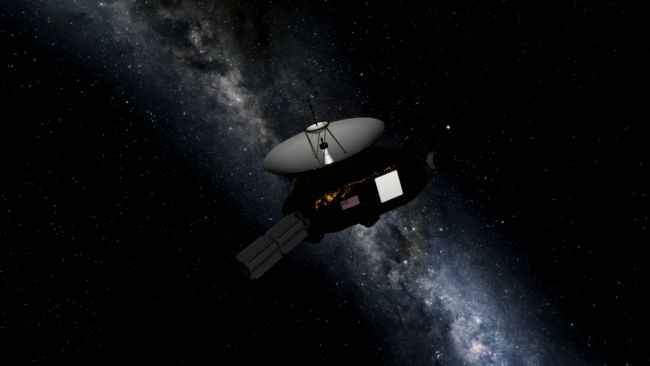
After the record-setting 2015 flyby of Pluto and its moons, the New Horizons spacecraft continued its journey through the outer reaches of the Solar System. In that same year, NASA selected a new target for New Horizons to observe: a Kuiper Belt object discovered by the Hubble Space Telescope the year earlier, known as 2014 MU69. Unofficially named Ultima Thule in 2018 based on a public vote, this object will be the most distant ever visited by a human spacecraft (breaking the record New Horizons itself set when it flew past Pluto).
The team says it hopes to set a new target for New Horizons once it passes Ultima Thule. With plenty of remaining fuel and equipment and instruments that remain in good condition, New Horizons is all set to head toward another distant object in the Kuiper Belt, arriving sometime in the 2020s, the team said.
Simulation Limitations
Simulations in Universe Sandbox are not perfect representations of reality. Rather, they’re meant to provide a visual — and as a result, a more intuitive understanding — of what is happening farther away than we can see or even imagine. With that in mind, there are a couple of limitations currently in this simulation:
1 – Trajectory
The trajectory shown is according to the NASA Jet Propulsion Laboratory’s orbital predictions as of September 2018. Additional maneuvering with thruster burns is expected, which would change the final trajectory. New Horizons will make an approach much closer than is represented in the simulation: it should pass about 3,500 km from 2014 MU69. Once actual trajectories have been recorded, we will update the simulation.
2 – Shape
Previous observations show that 2014 MU69 is likely not spherical, but rather cigar-shaped. Researchers suspect that Ultima Thule may even be two separate bodies that are either orbiting very closely as a binary or actually touching each other, which is called a contact binary. We should know more once New Horizons sends back data from its flyby! Right now, Ultima Thule is represented in Universe Sandbox as just a single, spherical body.
Other Far Out Objects
Update 22.1 of Universe Sandbox added three other simulations that feature very distant objects in our Solar System.
1 – Voyagers 1 & 2 in Interstellar Space
In November 2018, more than 40 years after its launch, and long since trips past Jupiter, Saturn, Uranus, and Neptune, the Voyager 2 probe entered interstellar space. It now joins its twin, Voyager 1, in exploring beyond our Solar System. They are expected to continue to send back data until they run out of power in 2025.
Home > Open > Voyagers 1 & 2 Start 2019 Outside the Solar System
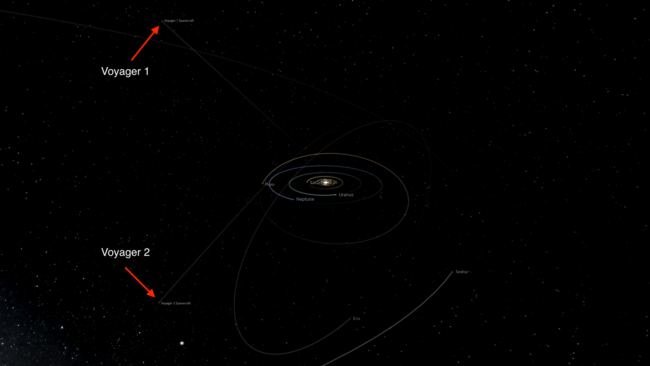
2 – 2018 VG18, “Farout”
On December 17, 2018, astronomers announced the discovery of the most distant known object in the Solar System, 2018 VG18. Nicknamed “Farout” (can you guess why they chose that name?), the trans-Neptunian object is currently around 120 AU (1 AU is the distance from the Sun to the Earth) from the Sun. While this object is the most distant ever observed, there are other known objects, like Sedna and the Goblin (see below), that have orbits that take them much farther from the Sun.
Farout’s orbit shown in this simulation is a preliminary estimate; its distance means it will take years of observation before its precise orbit is known.
Home > Open > 2018 VG18: The Most Distant Object in the Solar System
3 – 2015 TG387, “The Goblin”
On October 1, 2018, astronomers announced the discovery of the trans-Neptunian object 2015 TG387, which they nicknamed “The Goblin.” It was observed at about 80 AU from the Sun, but because of its extremely elongated orbit, it likely travels to a distance of more than 2300 AU at its farthest point.
Home > Open > 2015 TG387: A Goblin at the Edge of the Solar System
The Extremes of Our Solar System | Update 21.3
Oct 4th
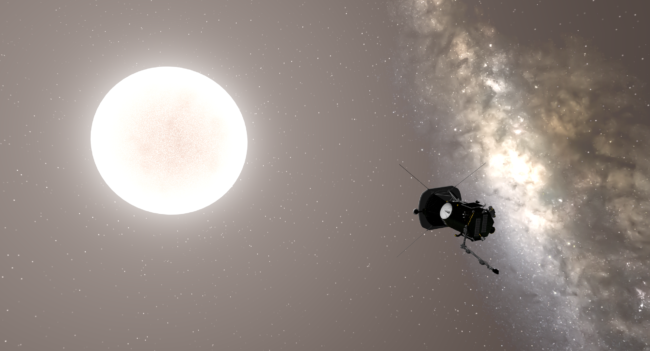
Run Steam to download Update 21.3, or buy Universe Sandbox ² via our website or the Steam Store.
This is a small update that features a new Parker Solar Probe model and new simulations exploring extremes in our Solar System:
Skim past the Sun with the Parker Solar Probe. The probe was launched in August and now has 24 trips around the Sun planned for its 7-year mission. Each year its orbit will take it closer to the Sun as its instruments capture data that will help us better understand our resident star. Its closest approach will bring it within 8.86 solar radii, or 3.83 million miles, of the Sun’s surface, more than 7 times closer than any previous spacecraft.
Home > Open > The Parker Solar Probe
Home > Open > The Parker Solar Probe’s Closest Approach to the Sun
Add > Objects > Parker Solar Probe
And ride along with New Horizons as it continues through the far reaches of our Solar System past Ultima Thule. After the probe’s flyby of Pluto and its moons in 2015, NASA selected the Kuiper Belt object Ultima Thule as its next target. When New Horizons makes its closest approach on January 1, 2019, Ultima Thule will become the farthest object ever visited by a spacecraft.
Home > Open > New Horizons Ultima Thule Encounter in 2019
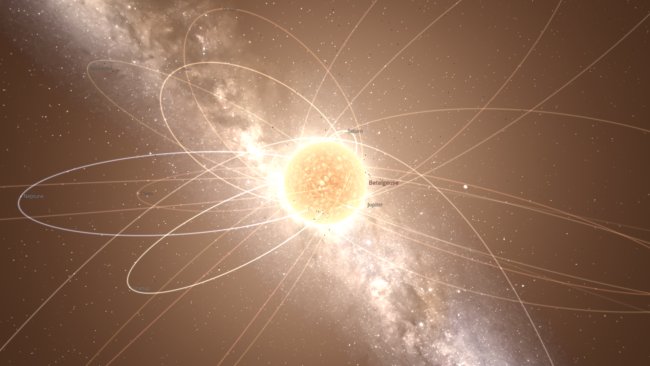
Plus: what if our Sun was replaced with one of the largest known stars in the universe, the red supergiant Betelgeuse?
Home > Open > Solar System with Betelgeuse Instead of the Sun
This update also includes an improvement to the accuracy of positions for moons and other objects in the Solar System Now & Real Time simulation, plus a few other smaller improvements and bug fixes.
Check out a full list of What’s New in Update 21.3
Please report any issues on our forums (local forum | Steam forum) or in-game via Home > Send Feedback.
Universe Sandbox ² Featured in Vsauce Video
Nov 2nd
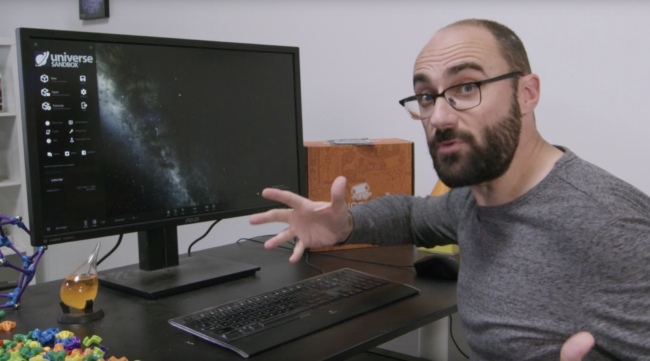
Friday, November 3rd: We’ve released Updates 20.2.3 and 20.2.4, which add two sims from this Vsauce video as well as a few improvements and bug fixes. See the sims in Home > Open.
Hey, did you hear that? Michael from Vsauce just gave some high praise of Universe Sandbox ²: “This simulator will blow your mind. I love it.”
Vsauce is a science and education YouTube channel that has attracted over 12.5 million subscribers with “videos that feed the curious and illuminate the amazing.”
We’re very honored and humbled to be featured in their latest video! Check it out below.
For the latest Universe Sandbox ² news, follow us on Twitter and Facebook.
See Asteroid 2012 TC4’s Trip Past Earth
Oct 13th
On October 12, 2017, asteroid 2012 TC4 passed Earth early in the morning, flying above Antarctica at around 1:42am EDT.
See its close approach in Universe Sandbox ²:
Home > Open > Historical > 2012 TC4 Passes Earth on October 12, 2017
The roughly house-sized asteroid passed just a bit beyond the orbits of communications satellites, well within the Moon’s orbit. This wasn’t close enough to pose any threat, but its orbit was slightly changed by Earth’s gravity, as you can see in the GIF above from Universe Sandbox ². Learn more on NASA’s website
For the latest Universe Sandbox ² news, follow us on Twitter and Facebook.
Ciao, Cassini | Update 20.2
Sep 14th

Run Steam to download Update 20.2, or buy Universe Sandbox ² via our website or the Steam Store.
November 3: Updates 20.2.3 and 20.2.4 are small updates which add two sims from the latest Vsauce video as well as a few improvements and bug fixes.
November 2: Update 20.2.2 is a minor update which includes a number of improvements and bug fixes.
October 5: Update 20.2.1 a minor update which adds a Cassini spacecraft model, Quicksave & Quickload (F5 & F9), and a number of smaller improvements and fixes.
On September 15, 2017, the world says goodbye to the Cassini spacecraft as it ends its historic mission with a final plunge into Saturn.
During its 13 years orbiting Saturn, Cassini made a number of invaluable discoveries about the planet, its rings, and its moons.
We now know that massive geysers covering the south polar region of the moon Enceladus shoot icy particles into space, forming most of Saturn’s E-ring and hinting at a massive, subsurface ocean. And we now know that the surface of Titan, Saturn’s biggest moon, shares a surprising number of characteristics with Earth, including dunes, mountain ranges, rivers, lakes, and seas.
With its array of sophisticated instruments, Cassini watched as storms raged on Saturn and seasons changed. It discovered eight new moons, provided insight into the behavior of its famous rings, and completely changed our understanding of its magnetosphere. The mission has been extended twice and now Cassini has been in orbit nine years longer than originally intended. Its fuel is nearly gone and so, to prevent possible contamination of any of the moons, its course has intentionally been set for disintegration in Saturn’s atmosphere.
So now we say ciao, Cassini. Thanks for all of your work.
And thanks to all of the hard-working scientists from NASA, the European Space Agency, and the Italian Space Agency who made the Cassini mission possible.
See Cassini’s final hours in Universe Sandbox ²
Home > Open > Core/Historical > Cassini collision with Saturn on September 15, 2017
Home > Tutorials > Science > What Is Cassini’s Grand Finale?
This update also includes a number of smaller improvements and bug fixes.
Check out the full list of What’s New.
For the latest Universe Sandbox ² news, follow us on Twitter and Facebook.
Science Works. Science Helps. Science Matters.
Apr 22nd
Observation. Hypothesis. Prediction. Experiment. Refine. Begin again.
Science is neither truth nor faith. Science is the process by which we reject or refine testable theories. These theories explain and predict the rules and processes that govern the behavior of the natural universe. Science doesn’t find universal objective truth; it narrows the error bars of our understanding. By its very definition, the scientific method works: if it is not reproducible, if it is not predictive, or if evidence rules it out, then it is rejected by science. And if it isn’t testable, then it isn’t in the realm of science (instead I would argue it is– and should remain– personal).
Science solves problems, and it solves them efficiently. Science makes us healthier, safer, more comfortable, and better at solving the problems of our daily lives. Applying the rigor of science to any decisions or areas of understanding that affect the lives of others can only serve to benefit lives and minds (for major decisions, not for when a friend wants you to choose the restaurant). Observation, hypothesis, prediction, experiment, analysis, adjust, rethink, repeat. We use the scientific method to make better meals, we can trust it to pick our diets, we can use the method to choose the best products, or to determine the best route to work.
Science and skepticism go hand in hand. We build our understanding of the world based on our observations of it, but also by the input of others. We can understand logical fallacies, accept new data, and test our assumptions against that data. In doing so, we can constantly refine and adapt our worldviews, and we can grow as people.
Science is not a political issue. The beauty of science is that it has to be reproducible and predictive. That means you don’t just have to believe what you are told. You can check for yourself! Some things might require expensive labs to verify, but if you, say, thought the world was flat, well you can check that!
Universe Sandbox ² is a live simulation that takes our understanding of the motion of objects and uses it to decide where each body will move as we step through simulation time. This matches closely to reality (at reasonable time steps, for non-relativistic situations) because science is reproductive and predictive. Society’s current understanding of physics allows us to send missions like Rosetta, or Juno, or New Horizons, billions of miles away to planned locations with an error equivalent to “throwing an object from New York and having it hit a particular key on a keyboard in San Francisco.”
Because this is how science works. Ignoring actionable, well-established scientific predictions is unconscionable. It’s plugging your ears and going “la la la” when someone tells you there’s an atrocity happening right behind your back, an atrocity that you have the power to stop. Not only can you turn your head and easily verify that the person is speaking the truth, but you can even do something to help, and instead you choose not to. Our choice cannot be to ignore this. Our choice matters. So today, I march for Science.
To very loosely quote Hank Green:
Science increases the Awesome and decreases the Suck in our world, and for that reason, I will always love it.
A note: I don’t want people confusing scientific institutions and cultures with the method itself. It is important to acknowledge the biases and failings of our scientific institutions historically and at present, especially with regard to equality and intersectionality, but let us not convolute science with academia or STEM institutions.
Celebrating Our Rare and Special Planet on Earth Day
Apr 22nd
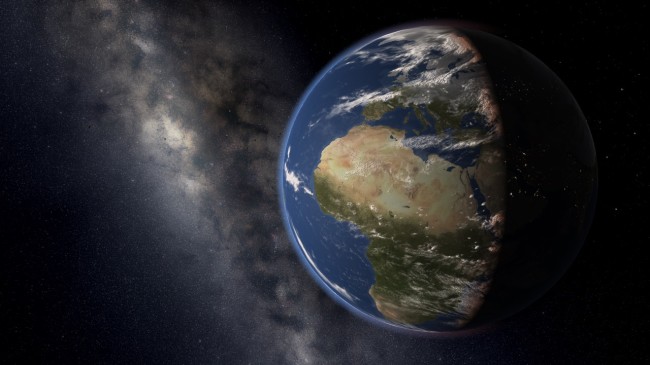
I hear a lot of people say that looking at our universe from a solar system, galactic, or cosmological scale makes them feel small and insignificant. Insignificant to who and what? I look at our universe and I see the incredible complexity that has arisen from a few forces and a few fundamental laws. You see it in the structure of the cosmic background, you see it in the shapes of galaxies, you see it in the heavy elements formed in our stars. Nowhere do you see that complexity more than when you look at life. It was a glorious accident that allowed us to exist, and we exist in an incredibly delicate balance.
99.99999999…% of the universe is empty space. 99.9999999…% of that which is not empty space is lifeless. Why does it matter if somewhere light years away something doesn’t care about your individual existence? We have this amazing planet and it might not be unique in the universe in its complexity, but it is incredibly rare and special, and I feel very significant — overwhelmed with a sense of purpose and duty, in fact — because it is up to us to try as hard as we can to preserve this rare and special place and all the life on it.
The structure of the universe doesn’t make me feel insignificant. It makes me feel incredibly lucky. By some chance I exist in this rare place. Thus it is my duty to try to keep life existing here, and to try to make that life as pleasant as possible for the other rare and lucky creatures who share it with me.
– Jenn Seiler, astrophysicist and Universe Sandbox ² developer.
Learn how we simulate Earth’s climate and how you can explore it in Universe Sandbox ²:
Working Through the N-Body Problem in Universe Sandbox ²
Feb 26th
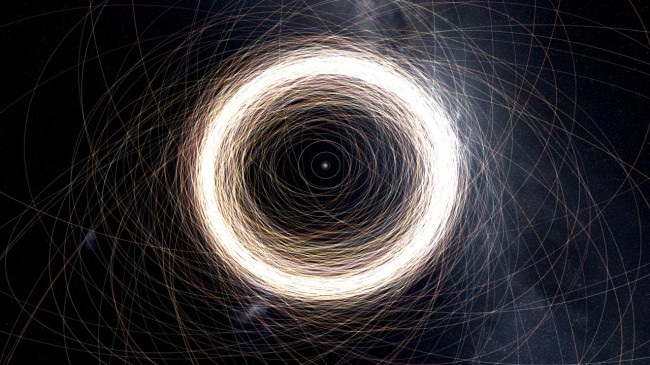
Orbits of major planets and all possible dwarf planets in our solar system. (From Universe Sandbox ²)
What is the n-body problem?
The n-body problem can be defined as “the problem of predicting the individual motions of a group of celestial objects interacting with each other gravitationally.” Or, in a gravitational system of n bodies (where n can be any number), where will they all be after one year?
It’s helpful to frame this in contrast to the two-body problem, which looks at the motion of just two objects interacting with each other. For example, you can look at the Earth and Moon as a two-body problem. The Earth pulls on the Moon quite a bit, keeping it in orbit, and the Moon pulls on the Earth just a little bit.
The issue here is that the Moon is not affected gravitationally by just the Earth; it is also being pulled by the Sun, and Jupiter, and every other object in space. The same is true when looking at the Sun and Earth: the Sun is not the only object pulling on Earth. So to account for all of these gravitational forces, you need to use an n-body solution.
The problem of the n-body problem in Universe Sandbox ²
In Universe Sandbox ², every object is simulated as part of an n-body problem. Unfortunately, when solving for many objects, or n objects, you can’t just jump forward in time without getting massive errors. There’s simply no way around this. Solving an n-body problem requires calculating how each object affects each other object every step of the way. Errors will still happen, but taking smaller steps reduces them.
By default, the simulations in Universe Sandbox ² try to set an accuracy which prevents orbits from falling apart due to error. This means setting a maximum error tolerance for each step and also making sure the total error doesn’t reach an upper limit.
If you crank up the time step, the simulation then has to take fewer, larger steps. This means the potential for greater error. And the greater the error, the more likely it is that an orbit, which otherwise would be stable, falls apart. Moons crash into planets, Mercury gets thrown out of the solar system — things like that.
This isn’t what most people want in their simulations. But at the same time, most people also don’t want a limit on how fast they can run their simulation. This is a problem.
An imperfect solution
So how can we get around this problem? How can we accurately simulate thousands of objects while still allowing for large steps forward in time? For example, what if you wanted to simulate our solar system on a time scale of millions of years per second so that you could see the evolution of our Sun?
One solution proposed by Thomas, our physics programmer, is to allow for a special mode within simulations running at high time steps. This mode (which of course could be toggled) would collapse the existing n-body simulation into a series of 2-body problems: Moon & Earth, Earth & Sun, Europa & Jupiter, Jupiter & Sun, etc.
Solving a 2-body problem is much easier than solving an n-body problem. Not only is it faster computationally, but there is also a relatively arbitrary difference between figuring out where the two objects will be in one year and where they’ll be in a million years — it still requires just one calculation. So if you collapse an n-body simulation into a series of two-body problems, the simulation could take one big step forward, instead of taking the small steps needed for calculating it as an n-body problem.
The results won’t be entirely accurate, as this method would effectively ignore all gravitational influences outside of the main attractor. As mentioned before, calculating Earth’s orbit by looking at how it interacts with just the Sun is not accurate, as Earth is also affected by every other body. The Sun, however, is the most significant factor by far, because it is much more massive than any other object in our solar system. The other, much smaller forces tend to have little effect overall in non-chaotic systems. So while it’s not correct, it’s close enough when simulating something relatively stable like our solar system.
This isn’t a perfect solution. But we think it could be an improvement over the current system and its limitations, which leave you with the choice of either destabilizing the orbits with massive errors, or waiting days for the simulation to advance the millions of years needed for the Sun to evolve. Neither is particularly interesting.
When is this coming to Universe Sandbox ²?
Not anytime soon.
This solution is just a proposed idea right now, and is not a high priority for us, as we already have a big list of exciting features planned. But we think it is useful to understand the complexity of accurately simulating the motions of hundreds to thousands of objects interacting gravitationally.
This is especially a challenge when attempting to do this in real-time on a home computer, which is why researchers run numerical simulations on supercomputers which take days to complete. With Universe Sandbox ², we’re exploring new territory and working through problems which haven’t been solved before. And this is a big part of why we love making it.
Gravitational Waves & Universe Sandbox ²
Feb 15th
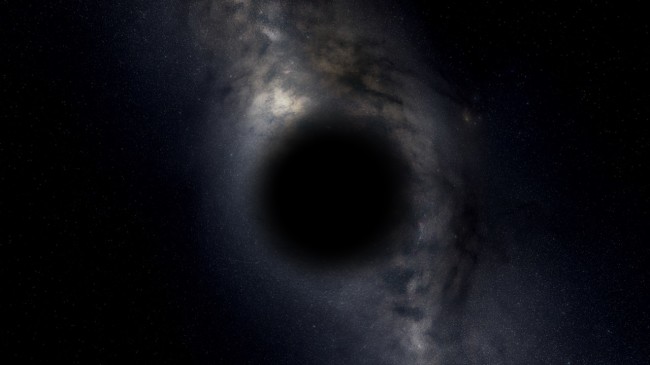
A black hole in Universe Sandbox ². Researchers concluded the detected gravitational waves resulted from two black holes colliding.
What’s the significance of discovering gravitational waves?
This announcement is a huge deal. It is on par with the discovery of the Higgs Boson particle which provided the missing evidence for a prediction of the Standard Model of particle physics. Gravitational waves are a century-old (almost exactly) prediction now confirmed by a huge number of relentless, and brilliant people after many years of hard work. It is the first direct confirmation of the prediction from Einstein’s General Relativity that matter and energy determine the motion of bodies by warping the fabric of spacetime itself, and in so doing, emanate ripples when massive bodies are accelerated through that space.
It is not only confirmation of general relativity, though. It is also the first of many future observations that will look at the universe in a completely new way. Up until now we’ve used only photons (telescopes all along the electromagnetic spectrum) and sometimes neutrinos. Now we can add listening to the fabric of space to our list of tools. This will allow us to see the dark and the obscured parts of the universe: the early universe, centers of galaxies, things blocked by dust clouds, and so on, by listening for changes in space itself. It is the start of a new age in astronomy.
In addition to this detection being the first direct proof that the predictions of general relativity that matter and energy warp space time are true, and some of the strongest evidence for the reality of black holes, this is also a new kind of astronomy. Though gravity is the weakest force and gravitational waves are very hard to detect, they do have a few advantages over observations of photons.
- First, gravitational waves are practically impervious to matter in their path. This means we can see into regions of space that are blocked to optical observatories, such as inside dense clouds of dust, the centers of galaxies, behind large or close bodies.
- Second, this is an observation of the warping of space itself, meaning we can detect things that have mass but might not produce observable light, such as black holes, dense sources of dark matter (if such were to exist), cosmic string breaks, etc.
- Third, gravitational waves fall off in amplitude much more slowly than light. This means that we can receive signals from very far away that we might not notice optically.
- And fourth, because gravitational waves also travel at the speed of light and don’t have to bounce off intervening matter, and begin to be potentially detectable from bodies getting close rather than just after the moment of collision, this means that we can work with other telescopes and tell them “Look over there! You’re probably going to see something exciting!”
This all of means that this detection means the beginning of a new kind of observational astronomy, as well as a better understanding of of of the fundamental forces of the universe, gravity.
What role did Jenn, astrophysicist and Universe Sandbox ² developer, play in the discovery?
While I was in the field I ran super-computer simulations to make predictions about the gravitational wave signals that would be produced by binary black hole mergers. Those waveforms are used as templates in the detector pipeline. The detector matches the template banks against the incoming data to find real signals amidst the noise of the detector, while also doing searches for large burst signals (how this one was found). Those waveforms are then used again to determine where the signal came from, what it was (two black holes, a neutron star and a black hole, two neutron stars, etc), and the properties of the bodies that created the signal (spins, masses, separation, etc.). I also worked on developing the analytical formulas to determine those spins and masses from those signals.
Here’s one of the scientific papers on the process of determining the properties of the source of the signal, with three papers cited on which Jenn Seiler was an author:
https://dcc.ligo.org/public/0122/P1500218/012/GW150914_parameter_estimation_v13.pdf
The Einstein equations for general relativity are ten highly non-linear partial differential equations. This means that it is only possible to obtain exact solutions for astrophysical situations for some very idealized conditions (such as spherical symmetry and a single body). In order to predict the gravitational waveforms produced by compact multi-body systems, or stellar collapse, it is necessary to solve the equations numerically (computationally). This means formulating initial data for spacetimes of interest (such as two in-spiralling black holes of various spins and mass ratios) and evolving them by integrating the solutions of the Einstein equations stepping forward in time by discrete steps. To prove that these computer simulations approximate reality more than just by equations on paper we would run these simulations at multiple resolutions for our discrete spacetimes and show that our solutions converged to a single solution as we approach infinite resolution (that would represent real continuous space) at the rate we expect for the method we were using.
There were many obstacles in creating these simulations: vast amounts of computational power required for accuracy; the fact that we needed to run tons of these large, slow, computationally intensive simulations in order to cover the parameter space (spins, masses, orientations, etc) of potential sources of gravitational waves; and so on. For black holes, one major challenge was the fact that they contain a singularity. A singularity means an infinity, and computers don’t like to simulate infinities. Numerical relativity researchers had to find a way to simulate black holes without having the singularity point in the slicing of the spacetime integrated in the simulation. The first successful simulation of this kind didn’t happen until 2005 (http://journals.aps.org/prl/abstract/10.1103/PhysRevLett.95.121101).
Once we had working simulations, groups around the world set to work on simulating the gamut of major potential gravitational wave signal sources. These simulation results were not just useful to the detectors to help identify signals, but also to the theorists to help formulate predictions about the results of such astrophysical events. Predictions such as: the resulting velocity of merged black holes from binaries of various spins, the amount of energy released by black hole mergers, the effect that black hole spins have on the spins and orbits of other bodies, etc.
When will you add gravitational waves into Universe Sandbox ²?
We really can’t do gravitational waves in an n-body simulation, which is the method Universe Sandbox ² uses to simulate gravity. N-body simulations look at the effect that each body has on each other body in a system at small discrete time steps.
General relativity requires simulating the spacetime itself. That is, taking your simulation space, discretizing it to a hi-res 3-D grid and checking the effect that each and every point in that grid has on all neighboring points at every timestep. Instead of simulating N number of bodies, you are simulating a huge number of points. You start with some initial data of the shape of your spacetime and then see how it evolves according to the Einstein equations, which are 10 highly non-linear partial differential equations. Accurate general relativity simulations require supercomputers.
There are some effects and features related to relativity that would be possible to add to Universe Sandbox ², however. Here are a few we are discussing:
-
Gravity travelling at the speed of light.
-
Currently if you delete a body in a simulation, the paths of all other bodies instantly respond to the change. The reality is that it would not be instantaneous; it would take time for that information about the altered gravitational landscape to reach a distant object.
-
-
Spinning black holes.
-
Most black holes are very highly spinning. If you imagine a spinning star collapsing it is easy to understand why. This is the same effect as when a spinning figure skater pulls in their arms; because of conservation of angular momentum, they spin faster. A consequence of this spin is that, while the event horizon would remain spherical, there would be an oblate spheroid (squished ball) around the black hole called an ergosphere. This ergosphere twists up the spacetime contained within it and accelerates bodies that enter this region (as well as affecting their spins). Because it is outside of the event horizon, this means one can slingshot away from this region and even steal energy from the rotation of that black hole.
-
-
Corrections to the motions of bodies to approximate general relativity.
-
Loss of momentum due to the emission of gravitational waves causes close massive bodies to inspiral. With this you could recreate the decaying orbits of binary pulsars.
-
Spins of close bodies affect each other’s motion and spins (see above). This would give you things like spun up accretion disks around black holes.
-
These corrections would be made by adding post-newtonian corrections to body velocities.
-
Learn more
Bad Astronomy article: LIGO Sees First Ever Gravitational Waves as Two Black Holes Eat Each Other
Video and Comic Explaining Gravitational Waves
Reddit AMA (Ask Me Anything) by LIGO Scientists
Paper by LIGO Researchers: Observation of Gravitational Waves from a Binary Black Hole Merger
